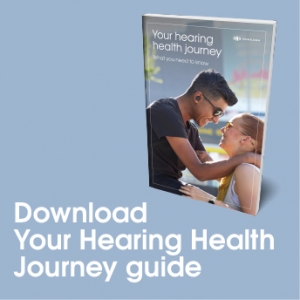A Guest Contribution by H.-P. Weihmann
This is an independent review and the opinions and evaluations were conducted by the author
“Not really hearing aids” gone cool
I was lucky enough to get an hour of Dr. Alan Davis valuable time allocated during my visit at the Audiology Now Conference a few months ago in Nashville, TN, to have a first-hand experience of the newly launched IQbuds BOOSTTM by Nuheara. So – what’s to say about this “new kid on the block” with regard to hearables for hearing loss that allow you not only to stream your music (yes-with exceptional sound quality), make your phone calls (with very good speech understanding), but to enhance your hearing capabilities in those situations where you always wanted to boost your hearing – without having to wear traditional hearing aids.
“The new IQbuds BOOSTTM are a bit like reading glasses for the ear”
Let´s be clear – the IQbuds BOOSTTM will not replace classical hearing aids for those who suffer from moderate to severe (or even higher) hearing loss – but they are rather interesting alternatives known as for those who only wish to hear better in specific listening situations as they are facing the beginnings of mild hearing losses. And guess what – I am one of those guys, who is a perfect example for this target group (baby boomers, regular concert goers and loud music listeners) that is somewhere in his late 40-ies. This target group (45y – 65y) represents 25% of the population in industrialized countries and is exactly the potential customer this product caters to. However – it’s also this group of customers that is not (yet) ready for hearing devices and thus will never walk into an audiologist’s office to purchase hearing aids but will become more and more interesting for the industry due to the introduction of the US Over-the Counter Hearing Aid Act of 2017.
“The new IQbuds BOOSTTM are a bit like reading glasses for the ear” says David Racicot, Nuheara´s Head of Sales and Business-Development Americas. “You wear them when your need them and when you feel like wanting to have all sounds and speech slightly louder – and tune out the world when you want to enjoy your music.”
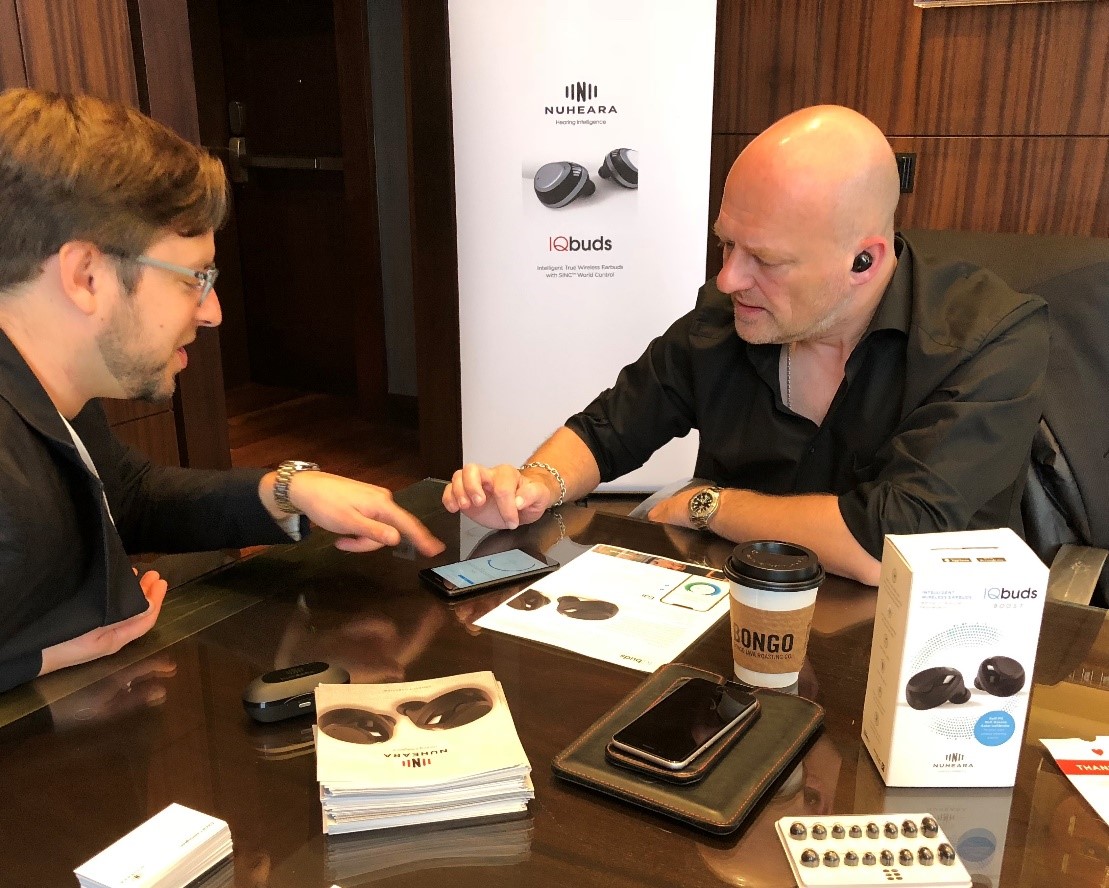
Pic 1: Dr. Alan Davis explaining the IQbuds Boost to H.-P. Weihmann (Picture: courtesy of D. Racicot, Nuheara)
Setting the stage to make them work
After fitting the devices to my ears (they come with nine different plugs to fit as tight as possible into your ears) and pairing them with a test-smart phone, Alan explained how to do the Ear IDTM in order to calibrate the IQbuds BOOSTTM to my specific hearing needs.
Basically, the Ear IDTM works like a hearing test you’d have performed at any audiologist’s office or at your local ENT practitioner
Basically, the Ear IDTM works like a hearing test you’d have performed at any audiologist’s office or at your local ENT practitioner – but in this case you’re doing a self-assessment of your hearing loss.
Each ear is presented 6 different frequencies (from the higher to the lower frequencies) and you are asked to touch the screen when you hear the tone as softly as possible. This is rather easily done in very quiet environment but will be much harder to do as soon as you have some environmental noise around you.
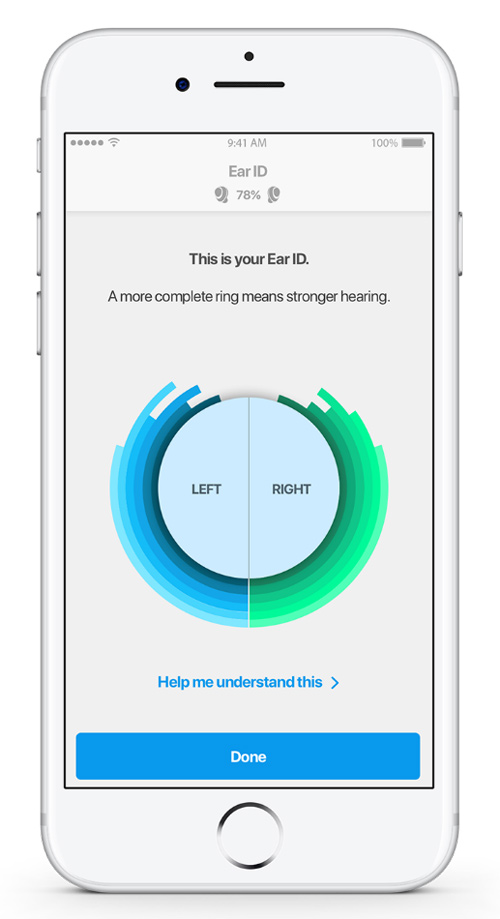
Pic 2: Ear ID results after the test
The whole test takes just 5-8 min / per ear (depending on your hearing threshold) as each test-tone will be presented more that once and the test will only continue if you touch the screen – or if you did not react at all after a certain time.
Calculating the audio settings
After the successful completion of the Ear IDTM test, the devices calculate the individual and fully personalized audio settings based on the results of the hearing test using the well-recognized NAL-NL2 fitting algorithm.
With Nuheara’s integration of the NAL-NL2 algorithm into the IQbuds BoostTM the traditionally separate worlds of hearing devices and hearables are growing closer than ever.
For the sake of maximizing speech understanding in difficult listening situations for occasional “hearing amplification” users the NAL-NL2 algorithm is best suited to fulfill those needs of the mild hearing-impaired customers.
The algorithm itself is proven million-fold per year due to the setting of hearing devices for hearing impaired people. With Nuheara’s integration of the NAL-NL2 algorithm into the IQbuds BOOSTTM the traditionally separate worlds of hearing devices and hearables are growing closer than ever. This offers incredible possibilities to both worlds (industries) as well as potential customers (suffering from mild to moderate hearing loss) that are now able to choose between hearing aids and “super cool” hearables.
However – keep in mind, that the IQbuds are not meant to be hearing devices. But having tested them for a couple of weeks now in different listening situations I believe that they are very good devices for people with mild hearing loss and for occasional use – and the emphasis is on occasional as you might not want to wear these devices every day all day long.
Focus – on what you want to hear
While writing this review of the IQBuds BOOSTTM, Nuheara launched the new focus feature that I also wanted to test right away after the launch. The convenient thing about these products is, that they are upgradeable – so anytime a new feature is launched just connect your IQ buds to your PC, use the upgrade function and get the new feature up and running in your buds.
Focus helps you to distinguish “noise” from speech and makes for easier conversations in loud environments.
Focus, focus, focus – what sounds like a mantra from your last management course is actually the new function of the IQbuds BOOST for situations in noisy environment. The new feature uses audio beamforming (that is nothing other than a new algorithm for the two microphones built into the IQbuds) and thus sets the microphones to “directional” mode in order to suppress sounds coming from behind you while talking with a person standing in front of you.
What’s that for – you might ask. Imagine having difficulties understanding in noisy listening situations such as a restaurant, party or in a open plan office. The “Focus” feature helps to “concentrate” on people talking in front of you while reducing the loudness of voices behind you. The higher the similarity of “noise” vs. “speech” (such as speech babble) the harder it is to understand what´s really said. Focus helps you to distinguish “noise” from speech and makes for easier conversations in loud environments.
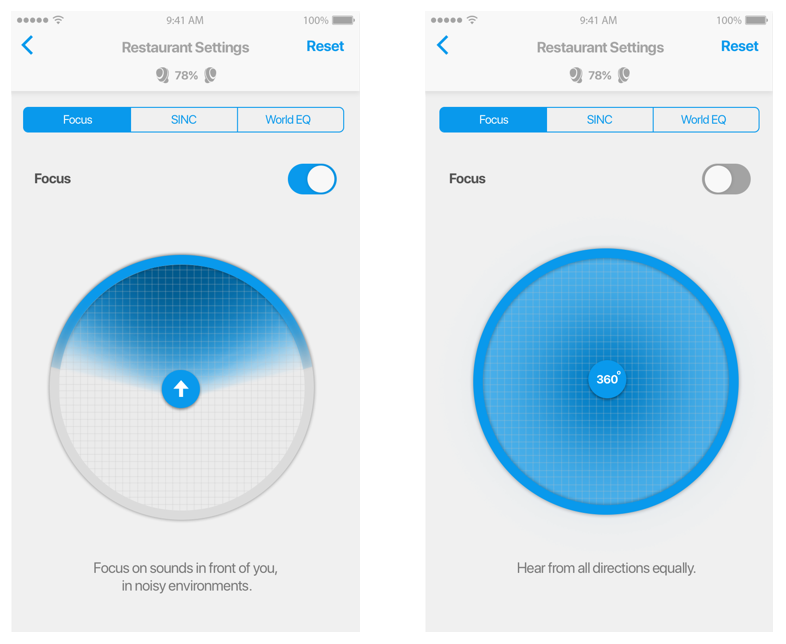
Pic 3: The “Focus” feature in the IQbuds Boost
What are IQbuds BOOSTTM really like?
If the IQbuds BOOSTTM don’t want to be hearing devices – what are they really like? Hearables for hearing loss is an apt description. They are headphones (earphones) that are first and foremost fully wireless Bluetooth enabled devices for listening to your music, talking on the phone or watching TV (if your TV has Bluetooth capabilities or with the use of a 3rd party transmitter) without disturbing others.
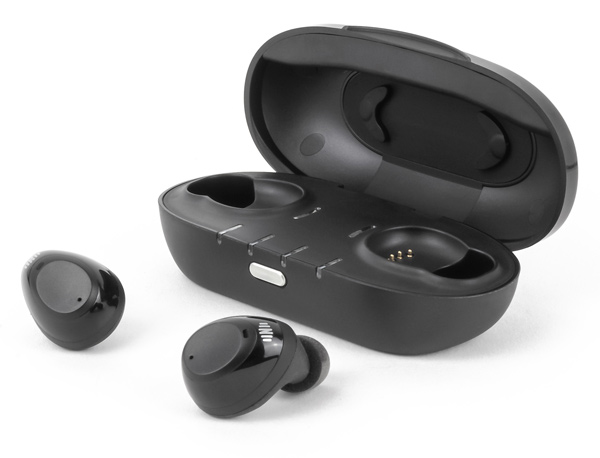
Pic 4: IQbuds Boost and the charger
The sound quality for streaming audio or for talking on the phone is excellent and if you want to cocoon in your own world you even can tune out your surroundings using the “World control” function that is basically a microphone volume control that turns on / off the build in microphones of the devices.
Having a closer look into the technical data sheets the IQbuds BOOSTTM are featuring technology and a set of functions well known from hearing aids:
The system works in 12 frequency channels using wide dynamic range compression (WDRC).
- Hearing loss results in a loss of sensitivity for soft sounds, with little or no loss of sensitivity for intense sounds. Thus, in order for the range of environmental sounds to fit within the residual dynamic range of the individual, more amplification is required for soft sounds than for intense sounds. The net result is that soft sounds are audible, moderate sounds comfortable, and intense sounds are perceived as loud without causing discomfort.
Feedback Management to avoid whistling of the devices while being worn in the ears
- This feature helps to reduce any bothering whistling sounds (that you for sure remember from your granny´s hearing aids) that might occur, when the devices are not properly fit in the ear.
A noise reduction (SINC noise reduction) to minimize environmental sounds
- The SINC (Super Intelligent Noise Control) noise cancellation system uses multiple microphones and an intelligent hearing processing engine to select and filter sounds transmitted to the ear and automatically adapts to the current environment the user is in. Through the Nuheara app the user can additionally select the amount of noise reduction and thus digitally adjust and personalize (increase or decrease) the volume of the world around him.
Directionality using the two build in microphones for better understanding in noisy environments
- The Focus feature is meant for difficult listening situations – mainly when a lot of people are in the same room talking to each other – and thus making understanding the person you talk to, much harder. The setting of the two microphones when “focus” is switched on, helps to suppress noise coming from behind and thus makes talking to a person in front of you easier.
World control to turn microphones on / off
- Tune out the world and environmental sounds around you to listen to your music, relax or cancel e.g. ambient noise in any given listening situation such as flying on a plane.
High fidelity audio with a frequency range from 100Hz to 12.000Hz
- The main frequencies for a better speech understanding are covered as well as the range that 45+ old ears are able to hear to enjoy music in high sound quality.
7 pre-set listening situations
- Home, Street, Restaurant, Driving, Plane, Office, Workout
Customizable, intelligent tap-touch control
Wearing comfort of the IQbuds BOOSTTM
As mentioned earlier you might not want to wear your IQbuds BOOSTTM every day all day long – this is not only due to the fact that you simply don´t need them all day long (remember – the devices are meant for the occasional use), but also to the fact that you will experience two things with the IQbuds:
- If you´re having small ears such as I do and your concha (ear-conch) is rather tiny, the wearing comfort might be slightly limited as the devices are big enough to fill out a normal sized concha. So, after wearing the devices for app. 2 hours I feel the need to take them out again as my concha starts to throb and I am growing pressure marks in my ear.
- As the devices have to fit properly in your ear to be able to conduct the Ear IDTM test and to have the most benefit from the amplification of the devices you will experience occlusion effects of your ear. Think “putting your fingers in your ear”, close your ears properly and start talking – this effect that you experience with your own voice is called “occlusion”. You´re getting used to it after app. 15-30 min, but still it might bother you when wearing the devices throughout the day.
However – it´s a bit like wearing a new pair of shoes – they might be a tight fit in the beginning – but after a while the start to fit better and better – so you just have to get used to it.
Evaluation and recommendation of hearables for hearing loss
After having tested the Nuheara IQbuds BOOSTTM for about 6 weeks I personally am fully satisfied with the devices as they do exactly what they were designed for – not more – but certainly not less.
Advantages
- Ear IDTM is an easy to use self-explanatory system that allows you to self-fit the devices using a self-assessment that automatically calibrates the devices to your individual hearing capabilities.
- IQbuds BOOSTTM aren’t hearing aids and don’t pretend to be – they are devices to stream your audio, talk on the phone (100% hands free) and help you to hear better in occasional specific listening situations. And if you have difficulties understanding people in moderately noisy situations then these devices should help you in those moments.
- The recently introduced “Focus” feature is a real advantage to listen and have a conversation in loud and noisy environments – and really adds to the usability of the product.
- They are introductory devices that will give you an idea of how amplification of speech and enhancement of speech understanding in difficult listening situations works.
- Compared to hearing devices the Nuheara IQbuds BOOSTTM are rather cheap and offer some really cool functions other than enhancing speech.
- These devices could help individuals with hidden hearing loss that is difficult to detect on traditional audiograms
Disadvantages
- They are not properly fitted for very small ears and this needs to be considered before you purchase the devices.
- Due to the close fit you will experience some occlusion while wearing the devices.
- The Ear IDTM test needs some patience – because if you really suffer some form of hearing loss you will not hear all of the presented tones during the test and thus have the “feeling” that nothing happens… however – stay tuned during the test to complete it for your own benefit of the extra amplification.
Even though most of the functions and the set-up of the devices is self-explanatory, I am convinced that sometimes customers might need some extra information. This information can be found on Nuheara’s website and mainly with the IQbuds BOOSTTM I assume that Nuheara will provide even more information and video tutorials in the near future. So, stay tuned.
A little word of audiologist’s advice
The OTC Hearing aid act of 2017 will bring more and more devices such as the Nuheara IQbuds BoostTM to the market and the newly developed Ear IDTM test is exactly what the industry is looking at if OTC devices have to be self-fitted by the customer.
What Nuheara has done with the Ear IDTM will lead the way for many of the OTC hearing aid manufacturers.
However – if you feel that you don´t hear as well as you used to but have never had your hearing properly tested at an audiologist’s office or an ENT practitioner I strongly advise, that you should get your haring capabilities checked out by a professional.
Hearables are the perfect addition to the whole industry in order to cater to those suffering from mild hearing loss as they offer a wide range of benefits to these hearing impaired “beginners”.
However, self-fit and self-assessment can have a huge impact on your hearing – so before you decide to get any of these “cool” devices you should make sure, that your hearing condition is not related to any medical induced problem.
You’re sure you don´t further impact your hearing capabilities with the use of a hearable? Then go and get your IQbuds BoostTM to have all the fun you can have with them – and enjoy the benefit of augmented hearing in difficult listening situations.
About the author: H.-P. Weihmann is an Independent Marketing & Product-Management Consultant based in Germany specializing in market analysis of different European markets as well as the US market, marketing strategy, branding, CI/CD development and marketing planning in the hearing health care (medical device) industry.
Before starting his own consulting company 6 years ago H.-P. was a Member of the global Key Management Team of Amplifon. He was employed as Director Marketing and Product-Management for Amplifon Germany (5+ years) and before that as Director Marketing and Sales Manager at Amplifon Switzerland (5 years). Previous experience includes the role as Product Manager and Chief Audiologist in a global role as well as Marketing Manager for Viennatone (a 100% daughter of GN ReSound).
H.-P. has more than 30 years’ experience in the hearing health care industry, holds a Master’s degree in hearing aid acoustics and is a well-recognized lecturer at the professional schools for hearing aid acoustics in Germany and Switzerland.

